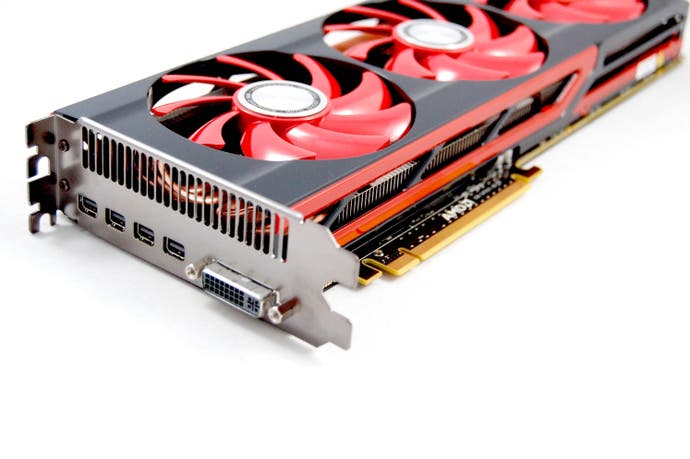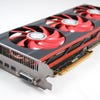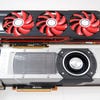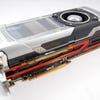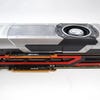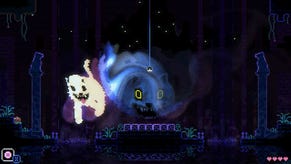Radeon HD 7990 review
Unparalleled power, but at what price?
Meet the graphics card that comprehensively out-scores Nvidia's GTX Titan on virtually every benchmark or gaming frame-rate test you care to throw at it. The Radeon HD 7990 - codenamed Malta - achieves its colossal performance levels by combining two top-end "Tahiti" graphics chips onto one board, running them at speeds exceeding 1GHz, and combining them with ultra-fast 6.5GHz GDDR5 memory. It's effectively two Radeon HD 7970 GHz Editions combined into one product, ensuring simply phenomenal compute performance. So why do the Nvidia competitors achieve so much popularity amongst enthusiasts while the HD 7990 has been largely overlooked by the community?
The answer is simple. Doubling up on silicon may well give you stratospheric benchmark scores - even in game engine tests - but the actual reality when you play games doesn't always match up to the experience suggested by those results. It's a state of affairs that has caused PC hardware sites to fundamentally reappraise the way that graphics cards are reviewed - a shakedown that is still in progress. Bar charts and context-free average frame-rate metrics aren't going away, but finally the hardcore PC enthusiast sites are beginning to acknowledge the overriding importance of the gameplay experience. In short, what comes out of the video output is getting priority over the numbers produced by benchmarks.
The crux of the issue is what is known as "micro stutter" - a situation where the graphics card powers through the work being given to it, but doesn't evenly pace the output of frames to the screen. Assuming v-sync is disabled, some frames get more time on-screen than others, some frames are barely represented, while - remarkably - others never make it to your display at all. Benchmarking tools like FRAPS can only measure the amount of frames generated internally; they have no way of tracking the latencies involved once they are pumped out to the screen. In our tests, single chip graphics cards are essentially unaffected, but in CrossFire/SLI set-ups - and dual chip products like the HD 7990 - there are issues, with AMD in particular getting some seriously bad press as a result.
A couple of months ago, AMD released new drivers said to address the issue, but we wanted to investigate - for a couple of reasons. Firstly, we're in line to review AMD's next contender for taking down the Titan and wanted some experience of the red corner's current high-end line-up - so we acquired both the HD 7990 and the 7970 GHz Edition for testing. Secondly, we wanted to know whether the latest drivers do fully resolve the frame-pacing issues because to put it frankly, the notion of having two top-end Radeon chips in one product is a truly exciting prospect and something we wanted to experience for the coolness factor alone. The imminent arrival of the AMD-optimised Battlefield 4 may also have played a small part in our desire to acquire this expensive piece of tech. And finally, the PC sites' talk of the gameplay experience made us wonder how the controversy would affect the way that we assess performance - not just on PC, but on console too. Of course, we've always based our analysis on the video output of the hardware under scrutiny, but any opportunity to improve methodology shouldn't be passed up.
Firstly, let's talk benchmarks. We're pretty clear about what we measure and why in our graphics card reviews. We shy away now from pure benchmarks like 3DMark and Unigine because our current stance is that performance from actual game engines is a much more valuable form of measurement, as it is more grounded in real life utilisation of graphics hardware. Secondly, owing to the sheer range of variables that can impact performance, we don't consider them representative of the gameplay experience as such - while they do cover off singular scenarios out of a multitude, we consider these benchmarks more as a useful way to measure relative performance of competing graphics technologies running the same game-based workloads.
On the latest drivers, the results of our tests are simply sensational - we're looking at anything up to a 30 per cent boost over Titan across a number of games. Now, bearing in mind that we're dealing with a two-chip solution overclocked significantly beyond the design's original clock speeds, clearly the HD 7990 isn't going to be winning any energy efficiency awards. But the XFX version of the card we tested proved fairly quiet in operation - and in actual fact, much quieter than the Sapphire Vapor-X 7970 GHz Edition we bought in to give context to the dual GPU results we were getting. Power draw is going to be significant, but we can safely assume that if you can afford a £500 graphics card, you probably aren't going to be that concerned about a few quid added to your fuel bill.
The only problem with these phenomenal stats is that the test results can't be entirely trusted. Alongside each of our standard 1080p and 2560x1440 tables you'll find video performance analysis, produced by using Nvidia's FCAT overlay tool - the de facto replacement for FRAPS. FCAT assigns coloured borders to the screen, allowing us to track the beginning of frames and their end when connected to a video capture device. We'd invite you to check out Tomb Raider and especially Sleeping Dogs - you'll find sudden performance drops out of nowhere, for no real reason that we could discern. At these points, frame-rates drop down to effectively match the single chip 7970 GHz Edition. All of that work done by the second GPU is momentarily lost - occupying just a thin slither of screen-time, meaning that in those moments you lose all the benefit of the price premium you paid on the card. A look at the sidebar to the left should clue you in on exactly how you're losing the performance.
Alternative analysis:
Our software screens out these so-called "runt" frames (not to mention the frames that are skipped entirely and never make it to the screen) and gives a performance reading that looks quite alarming. We can't call this micro-judder - macro-judder is clearly a more fitting description in certain scenarios. The immediate solution that springs to mind is to engage v-sync, lock to 60fps, and force consistency in refresh that way, but we suspect that this apparently simple cure-all doesn't work - dips below our target strongly suggest that those frames will arrive when they're good and ready, rather than sticking to the rigid 16.67ms vertical refresh schedule you set for them. FCAT again confirms that frames are internally rendered but never make it to the screen.
This may explain our next test - running Crysis 3 in our preferred gameplay conditions: quality and texture settings ramped up to the max, with sensible anti-aliasing engaged - 2x SMAA. Multi-sampling is available, but the post-process solution does the job just fine at higher resolutions and we mostly avoid the brutal hit to frame-rate incurred by MSAA. The results are telling. We see the Titan-beating performance you would expect most of the time, but it is marred by the occasional drop down to 7970 GHz Edition levels.
On the flipside, we have to point out that there are games where AMD's frame-pacing fix seems to work fine. In our test selection, BioShock Infinite and Metro: Last Light gave us the CrossFire scaling we wanted with none of the unwanted side-effects, resulting in a gameplay experience that does indeed beat the GTX Titan and the GTX 780 with no apparent drawbacks as we would have hoped from a card with this specification.
| 1920x1080 | HD 7990 | GTX Titan | GTX 780 | HD 7970 GHz |
|---|---|---|---|---|
| BioShock Infinite, DX11 Ultra DDOF | 126.7fps | 101.1fps | 94.5fps | 73.1fps |
| Tomb Raider, Ultra, FXAA | 189.8fps * | 130.2fps | 116.6fps | 94.8fps |
| Metro 2033, Very High, 4x MSAA | 76.5fps | 49.0fps | 47.5fps | 40.8fps |
| Metro: Last Light, Very High, SSAA | 52.3fps | 43.0fps | 40.0fps | 31.6fps |
| Hitman: Absolution, Ultra, 8x MSAA | 71.2fps | 49.8fps | 47.0fps | 31.0fps |
| Sleeping Dogs, Extreme | 97.3fps * | 66.5fps | 58.0fps | 50.9fps |
* - unreliable result owing to runt/skipped frames
Just to be clear here, all of the tests we've done were carried out on AMD's latest drivers, dated September 18 - some months after the frame-pacing issue was said to be resolved. We can well believe that there has been an improvement, but the issue is still enough of a problem to give us pause in recommending the card. At the price-point the HD 7990 commands, we should expect a consistency in throughput, but while overall performance is strong, those short, sudden drops down to single GPU output levels are very jarring indeed. We moved the card onto another PC and noted similar issues on the Sleeping Dogs benchmark - but with a variance in the exact location and frequency in the sudden drops in performance.
While it's unlikely that many of our readers have the budget to afford an HD 7990, the issue is still relevant in that it could scale down to other CrossFire configurations. Let's say that you've got an HD 7850 - one of the best price vs. performance cards on the market. Maybe you're thinking of buying another to complement your existing card rather than selling off your old tech and buying a shiny new GPU. On paper, those CrossFire benches are going to suggest a significantly improved level of performance, but the reality could be quite different.
While the "micro stutter" issue may not be fully resolved, we do think it's great that the work done in identifying the issue has turned the attention - just a touch - away from the bar charts and metrics that define the modern day PC GPU review, with the focus switching instead to what is actually experienced by the player. It's the approach we've had here on Digital Foundry since 2008, but the tests we've done with the HD 7990 bring into focus that our tools are not yet fully comprehensively addressing frame-pacing. You can interpret results along these lines to a certain extent from the graph line rendering, but they are still being averaged - so sharp, fleeting drops in performance are being smoothed out.
"Micro-stutter issues have been largely resolved - but there are still instances where very noticeable judder intrudes into general gameplay."
| 2560x1440 | HD 7990 | GTX Titan | GTX 780 | HD 7970 GHz |
|---|---|---|---|---|
| BioShock Infinite, DX11 Very High | 142.6fps | 94.5fps | 89.9fps | 75.5fps |
| Tomb Raider, High, FXAA | 172.9fps * | 119.3fps | 113.6fps | 84.2fps |
| Metro 2033, High, 4x MSAA | 57.6fps | 41.0fps | 39.5fps | 28.8fps |
| Metro: Last Light, High, No SSAA | 78.6fps | 53.0fps | 50.0fps | 40.6fps |
| Hitman: Absolution, High, 8x MSAA/2x MSAA | 52.3fps/ 76.6fps | 34.3fps/ 59.5fps | 32.0fps/ 58.0fps | 28.1.fps/ 53.4fps |
| Sleeping Dogs, High | 106.3fps * | 77.2fps | 67.4fps | 61.4fps |
* - unreliable result owing to runt/skipped frames
There are implications for our console testing too. Take, for example, Resident Evil: Revelations - PS3, 360 and Wii U versions all produce ballpark 30fps results, but the frame-pacing on the Nintendo console is haphazard, resulting in judder that isn't present on the other versions - the only evidence that something is amiss comes from fluctuations in the average frame-rate graph line. Our next challenge is to incorporate a real-time measure of consistency in our results that brings these issues to your attention. That's something we're currently working on and we hope to have a solution in place before we kick off with our next-gen console performance analysis articles in November.
Radeon HD 7990: the Digital Foundry verdict
Has AMD resolved the driver issues that impacted its reputation amongst enthusiasts? Our tests indicate that many games work fine, but others still exhibit occasional issues - and it is noticeable during play. When you're paying top dollar for a piece of graphics technology, you should do so in the knowledge that you're going to get consistent performance in all games. In the here and now, our experience indicates that this isn't happening, so the card is difficult to recommend against single GPU alternatives. If you've got the budget, GTX 780 remains the obvious choice, but a new high-end card is arriving imminently from AMD.
"While we have trouble recommending the HD 7990, our tests reveal that AMD's single-chip GPUs like the HD 7970 and HD 7950 are offering extremely strong value."
But let's give credit where it's due. While the HD 7990 didn't quite live up to our expectations, the single chip Radeon HD 7970 GHz Edition proved to be a great card - more than capable of holding its own against the GTX 770. After getting beaten out by Nvidia with the launch of its GTX 680 and Kepler graphics tech, it's clear that AMD has managed to remain fiercely competitive in the single GPU market with aggressive driver revisions and upclocked versions of its initial product line. We bought the HD 7970 GHz Edition to test against the HD 7990 we reviewed here, but if you look at the frame-rate tests and benchmark tables (which you can trust here), you'll see that it's clearly competitive against the GTX 770.
It's also a great auction buy on eBay, or second-hand from enthusiast forums - £225 is a good target price. Brand new prices for the card are falling too - presumably because its successor is due very shortly indeed. That's despite the fact that there's no new architecture in place for the replacements - they're still based on AMD Graphics Core Next technology, meaning that much of the new product stack will probably be an iterative improvement rather than a quantum leap in performance. Cards like the HD 7950, the 7970 and the GHz Edition will doubtless remain highly capable parts in the new order and they'll be cheaper still - the HD 7950 is now touching £170, which represents simply superb value.
Also worth noting is that AMD's higher-end cards typically come with a minimum of 3GB too - and the more GDDR5 you have in the next-gen console era, the better, something we noted in our Radeon HD 7950 review a while back. On top of that, AMD's potentially game-changing new API - Mantle - will also work just fine on the existing GCN cards too. In a world where an Xbox One costs $499/£430, there's clearly an opportunity to build your own PC for much the same price that should offer simply tremendous game performance.
But in the here and now, while we came out of the exercise disappointed that the sheer horsepower offered by the HD 7990 still doesn't translate into an overall gameplay experience that we can wholeheartedly recommend without reservations, it's clear that the price/performance ratio of the existing GCN line in general is ramping out significantly and could be shaken still further once AMD's imminent new offerings stand revealed.
